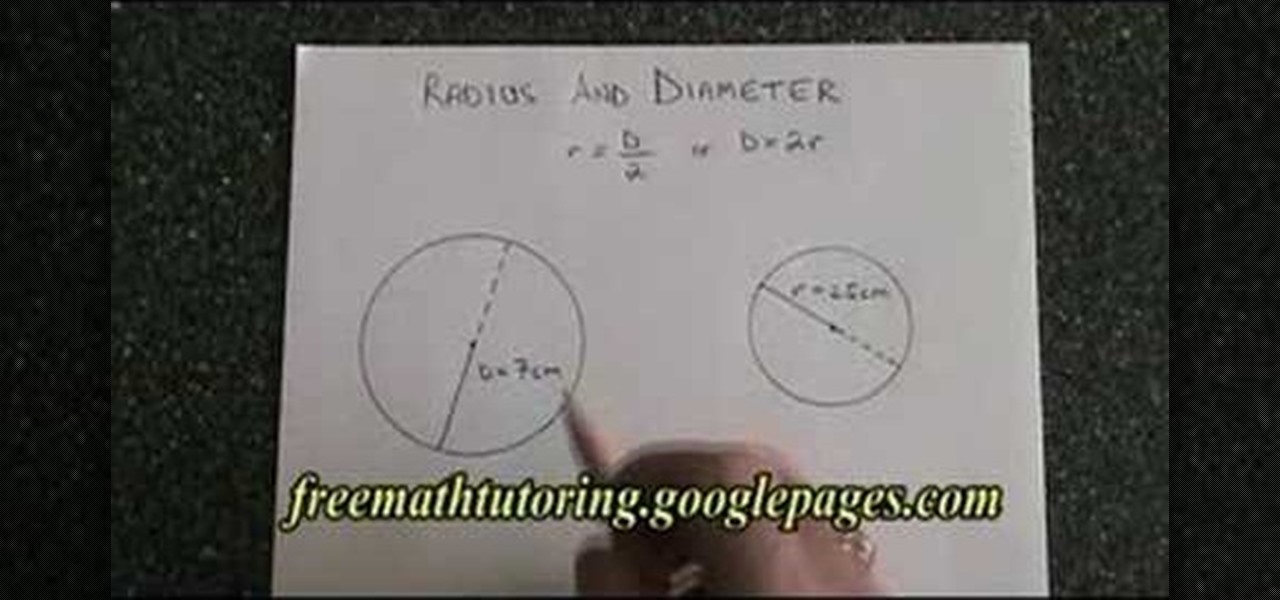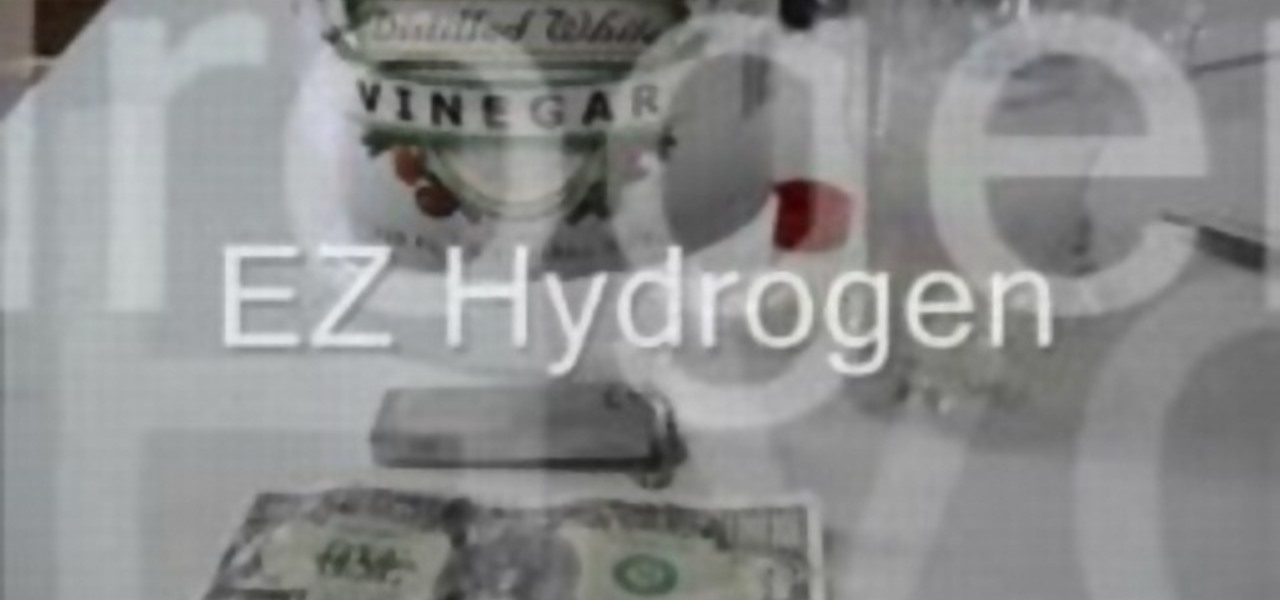Hot Education How-Tos


How To: Do long division
For anyone who has ever struggled with long division, this video offers some tips on how to perform this seemingly daunting task with relative ease. The example provided in this video is a very useful one and by following the steps of this video, you will be able to do long division easily. Starting from the right side of the number which is being divided, add 0's as place holders until you arrive at a number which can be divided by the number you want to divide by. Perform this one simple di...

How To: Find the volume of a cylinder
This is an excellent educational video on mathematics. This video teaches you how to find the volume of cylinder with an example. The volume of cylinder is the bottom area multiplied by the height. Here, the height is 12 inches and the radius is 9 inches. The bottom area is Pi r square=piix81 sq inches. volume = piix81x12 = piix972

How To: Find the surface area of a cylinder easily
In this video tutorial the author shows how to find the surface area of a cylinder. He shows a four step approach to solve this problem. First he gives us a formula to find the surface area of a cylinder, where Surface area A = 2 * Pi * R * R + 2 * Pi * R * H, where R is the radius of the base of the cylinder and H is the height of the cylinder. Now he identifies those values and substitutes them in the formula giving the surface area of the cylinder. This video shows how to compute the surfa...

How To: Create a crazy ketchup packet water bottle experiment
This video displays a very interesting experiment or magic trick involving the concepts of density and buoyancy. You will need an empty plastic bottle with its label removed, some water, and a ketchup packet. Using the concepts of pressure and density, this video demonstrates an interesting experiment which can also double as an interesting party trick; by squeezing a full water bottle, you can cause the ketchup packet to rise and sink in the bottle at your whim. This video is an interesting ...

How To: Convert between diameter and radius
To convert between diameter and radius just follow a few steps. Sometimes we aren't given the number directly so first we need to find the diameter.

How To: Make a homemade hot air balloon
Think a hot air balloon is something you can only read about in books? Think again. In this six-part science based tutorial, learn how to make your very own hot air balloon using science & the following easy to find materials: plastic bags, plastic drinking straws, thin candles, aluminun foil, tape, and scissors.

How To: Learn Calculus in 20 minutes
Did you sleep all semester in your Calculus class? Are you just waking up now to realize you have a test on Monday and that you're totally screwed? Well, luckily you can learn an entire semester worth of Calculus in just twenty minutes... or at leasts that's the hope.

How To: Calculate percentage
Not sure exactly how to calculate a twenty percent tip for your waitress? Or how about how to figure out how much less your cost will be with that thirty percent off tag? Use these steps to calculate percentage, without a calculator.

How To: Make iodine from hydrochloric acid and H2O2
Watch this science video tutorial from Nurd Rage on how to make iodine from an alkali metal iodide, hydrochloric acid (HCI), and hydroxide peroxide (H2O2).

How To: Make silver chloride for a photochemistry test
Watch this science video tutorial from Nurd Rage on how to make silver chloride for a photochemistry test. They show the chemistry of photography using silver chloride that they make themselves from table salt and silver nitrate.

How To: Make glass mirrors with silver nitrate
Watch this science video tutorial from Nurd Rage on how to make a mirror silvering solution from silver nitrate, ammonia, sugar, and sodium hydroxide.

How To: Perform Separation by Decantation in the Chemistry Lab
Find out how everything in a chemistry lab works, from pipettes to burners to recrystallization to storage. You'll get precise instructions on how to work and perform certain scientific duties in the chem lab, whether it's chemical or just ordinary high school science.

How To: Carry out a titration in the lab
The Interactive Lab Primer (ILP) has been developed as part of the Royal Society of Chemistry Teacher Fellowship Scheme, one of the themes of the Chemistry for Our Future program, and initiative which aims to secure a strong and sustainable future for the chemical sciences in higher education. The aim of the ILP is to address the diverse range of experience and skills students bring with them to a university by offering a resource to support their transition from school to the university chem...

How To: Use the Unicam UV-visible spectrometer in the lab
The Department of Biological Sciences at the University of Alberta brings you this video tutorial specifically relevant to your student laboratory courses, specifically microbiology. If you're a student at any school of biology, this information will be helpful for learning how to use the Unicam UV-visible spectrometer, split beam and internal printer in the lab.

How To: Solve problems related to factors, multiples, & primes
Check out this instructional math video that reviews Elementary Number Theory, which is a fancy way of saying these are problems related to factors, multiples, prime numbers and remainders. In the 12th lesson, learn how to solve SAT math problems. Here are the math problems and their page numbers that this video covers:

How To: Perform the Barus effect
Watch this instructional science video to observe the Barus effect in action. A dyed solution of POLYOX (polyethylene oxide - it is the stuff used as the lubricant on the strip found in all modern razors) is extruded from a 50 mL syringe. On exit, a marked swelling in the liquid stream several times the diameter of the orifice is observed. The effect is referred to as the Barus Effect, but it also goes by several other names including the Merrington Effect, Die Swell, and Extrudate Swell.

How To: Conduct a magic floating boat science experiment
Check out this video tutorial to see how to conduct a magic floating boat science experiment.

How To: Dissect a female pig reproductive tract
Ever wondered about the reproductive tract of a female pig? Well, these video tutorials will tell you all you need to know about the anatomy of a sow's reproductive tract.

How To: Dissect a female reproductive tract of a mature hen
In this video tutorial two-parter, you'll see how to dissect the female reproductive tract of a mature laying hen for an anatomical look.

How To: Grasp the brachial plexus in humans
The brachial plexus is a collection of nerves that supply the upper limb. It has three functions; motor innervation of skeletal muscles, sensory innervation of skin and muscles, and sympathetic innervation of the skin, specifically the sweat glands, and blood vessels.

How To: Make hydrogen with vinegar and magnesium
Learn an easy way to make hydrogen with vinegar and maganesium. This experiment is dangerous, so please exercise caution.

How To: Make mothballs jump
If you put mothballs in a solution of vinegar and baking powder, the balls will collect air bubbles; then after they cause the balls to rise, the bubbles pop, and the mothballs drop.

How To: Make a ball of plasma in a microwave
There are about fifteen states of matter: solid, liquid, gas, plasma, et cetera. Plasma is commonly found in stars, and is a rare natural phenomenon here on Earth. In this video, I show you how to make artificial plasma in your microwave.

How To: Measure electrical resistance with a multimeter
This is a guided hands-on laboratory activity to help a student understand the proper and safe use of a multimeter to measure electrical resistance. These two video guides the student through the proper techniques for measuring resistance with a multimeter, but you'll need some assorted resistors, a rectifying diode, a photo cell, an electronic labs kit, and some other stuff.

How To: Subtract fractions and mixed numbers
See how to subtract fractions. Turn those mixed numbers into improper fractions to solve. Improve your math skills!

How To: Do this quick foot experiment to trick your brain
This week's experiment has made the rounds through the Internet as a strange trick, but there is science here too. We are going to use the science of complex systems to confuse your body. To try this, you will need:

How To: Make solid rocket fuel ignition with zinc and sulfur
Once used as solid rocket fuel because the reaction requires no oxygen, sulfur and zinc react vigorously. The reaction with zinc produces flame and a near explosion. Sparks fly and smoke billows in this dramatic chemical demonstration.

How To: Make a Sugar Snake from Sulfuric Acid and Sugar
Sugar (a carbohydrate) is dehydrated with concentrated sulfuric acid. Since a carbohydrate was once considered just hydrated carbon, if you remove the water, carbon would be left over. The acid rips the water out of the sugar and the heat generated by this reaction causes the water to turn to steam. A black mass of carbon is produced.

How To: Inflate a sealed balloon in a vacuum chamber
Want to learn the principles beyond Boyle's Law in a way other than just hitting the books and getting bored to death? Then a science experiment is key.

How To: Be a human calculator
Before we had the calculator and before we had the abacus we had the human brain to complete our math problems for us. Remember that? Well, it seems that few of us do, resorting to calculators on our phone for elementary subtraction problems and multiplication.

How To: Add Mixed Numbers Tutorial
This step by step video teaches how to add mixed numbers AKA mixed fractions easily!

How To: Convert a Mixed Number to an Improper Fraction Tutorial
This easy tutorial will show you how to convert a mised number into an improper fraction in a few easy steps.

How To: Divide Fractions Tutorial
An easy step by step video tutorial on dividing fractions.

How To: Multiply Fractions Easy Tutorial
In this step by step video I'll show you how to multiply fractions.

How To: Subtract Fractions with Unlike Denominators Step by Step
Learn how to subtract fractions with unlike denominators by watching this easy video tutorial.

How To: Subtract Fractions with Like Denominators
This easy video tutorial teaches how to subtract fractions with like denominators step by step.

How To: Add Fractions with Unlike Denominators Tutorial
This video tutorial teaches you step by step how to add fractions with unlike denominators.

How To: Add Fractions Tutorial
Learn how to add fractions with this easy step by step video.

How To: Make Your Own Salt Crystal
Video: .

How To: Make Edible Slime
A cool experiment for kids and parents that allows you to make edible Kool-Aid slime. The video attached gives the step-by-step process and shows how fun it is to create the final product.







